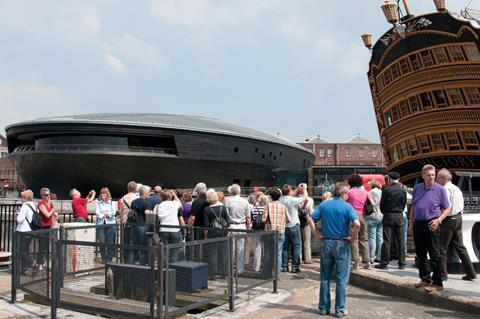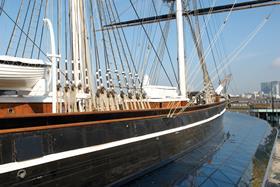There were three big boat-related events in 2012 but the award for the best themed building has to go to the Mary Rose Museum
MARY ROSE MUSEUM

This may well go down in history as the year of the famous ship. There were three big boat-related events, each accompanied by an ambitious project where clients and project teams milked the fame of the associated vessel to the max.
The tripartite celebrations kicked off with the centenary of the sinking of Titanic in mid-April. This turned into a major national event with TV programmes covering every aspect of the doomed ship, from how it was built to what the passengers ate for breakfast - and a museum dedicated to the doomed liner was opened on the very spot in Belfast where it was built. As the Titanic is sitting on the seabed, the building had to be suggestive of the long-lost liner. The result is a very literal interpretation of the subject, comprising four hull-shaped prows radiating from a central glass box with a recreation of the Titanic’s grand staircase inside.
Over in Greenwich, the troubled restoration of the tea clipper Cutty Sark was completed in April. Eaten away by centuries of rust and ravaged by a fire during restoration, the reinvigorated Cutty Sark’s dry dock home was transformed into an exhibition-cum-corporate event space. This is topped by a glass construction that is meant to be reminiscent of waves lapping around the hull, but looks more like a greenhouse on steroids.

This detracts from the dignity and heritage of the ship and sums up the overblown nature of this project.
The accolade of the most successful boat-related building has to go to the Mary Rose museum in Portsmouth (pictured above). Although it doesn’t open until next year, a milestone was reached in May. This building has been built around the hull of the venerable warship, which was hauled out of the Solent in 1982 after 437 years on the seabed.
The ancient timbers couldn’t be allowed to dry out uncontrolled, so it has been sprayed with polyethylene glycol. This displaces the water in the timber and once saturated the wood can be carefully dried out. The sprays stopped in May after 17 years and the wood will be fully dried in 2016. Full marks to the project team for keeping the sprays going at a constant 28ºC while building an elegant, understated museum around the boat. This project is the best example of the building paying appropriate homage to its contents.



























No comments yet